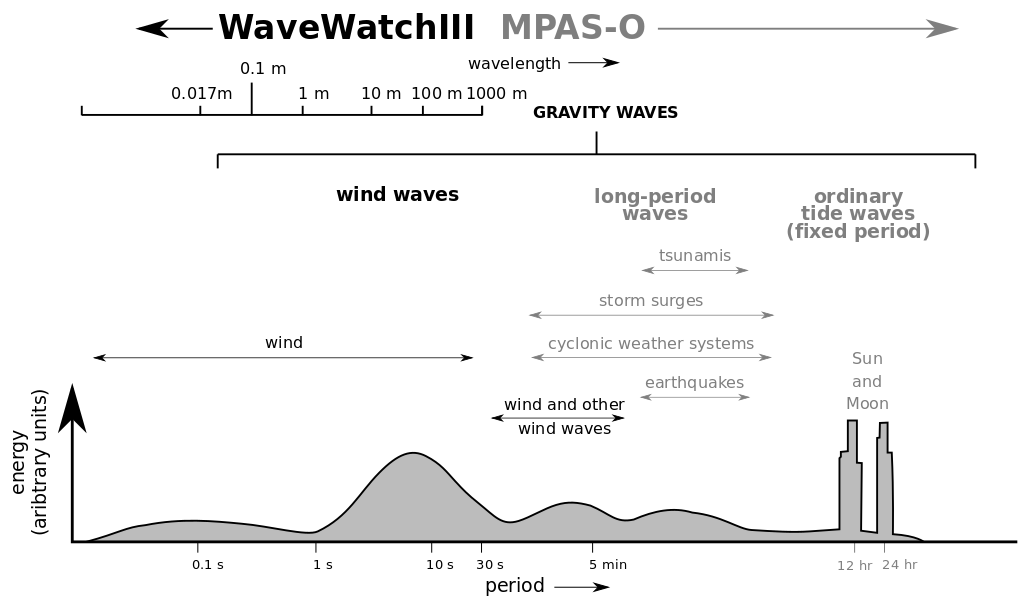E3SM Next Generation Development for Coastal Waves
WAVEWATCH III® is being introduced into the Energy Exascale Earth System Model (E3SM) to advance the simulation of coastal processes within E3SM. Currently, wind wave processes occurring at subgrid scales are not represented by the ocean model. Simulation of ocean waves will allow for improved modeling of sea levels during hurricanes. Furthermore wave, ocean, and sea ice interactions in the marginal ice zone are needed to properly simulate waves in high-latitudes and to better represent wave erosional fluxes to land-fast ice and continental ice shelves. These processes need to be included in E3SM in order to better represent cryosphere contributions to global and regional sea level rise. These two science applications (simulating wind waves, and modeling wave, ocean and sea ice interactions) are essential to understanding how coastal processes will evolve and affect critical coastal human infrastructure, including energy networks.
This work is challenging because it relies on feedbacks between the Earth System components (e.g., the ocean and sea ice) that arise from interfacial processes between different model components. These interactions require new coupled model processes that are affected by and affect the wind wave solution computed by WAVEWATCH III. Examples of new model-coupling process representations that are under development include: evolution of waves produced by the atmosphere that generate stresses on the ocean, Doppler shifting of waves by the ocean and atmosphere, and ocean-wave-sea ice interactions within the marginal ice zone. Each of these model-coupling processes affects the solution quality of the simulated waves and their feedback into the Earth System to mitigate model biases.

Figure 1. Scales of motions in the ocean from small, coastal scales (left side of schematic) to global ocean scales (right side of schematic). WAVEWATCH III is needed to simulate wind waves that cannot be directly resolved using MPAS-Ocean at wavelength scales smaller than 1000m (Figure adapted from Wright et al., 1999).
The reason wind waves are not presently simulated within the ocean is because the model grid cell size is too large, making waves a subgrid process. WAVEWATCH III can bridge this gap and parameterize these subgrid wind-wave effects, which are at wavelengths shorter than 1000 m and wave periods less than 30 seconds (see Fig. 1). Wind waves, swell, wave-wave interactions, and wave breaking are directly simulated in WaveWatch III. Wave and ocean interactions contribute to flooding and global mixing, with feedbacks for ocean-land interactions as well as the global feedbacks in the deep ocean via modified vertical mixing. The video above shows a WAVEWATCH III simulation capturing the 2005 hurricane season, and highlights the capability of waves to be simulated under tropical cyclones.

Figure 2. Wave and sea ice interactions in the marginal ice zone – adapted from Dai et al. (2019) and Sutherland and Dumont (2018). Waves are attenuated as they propagate through the sea ice zone. They contribute to the dynamics, growth, and melt within the pack, impacting established sea ice most obviously via changes to the floe size distribution, which is the size distribution of plates of ice that give a cracked eggshell appearance to the pack. Moving from left to right in the figure, waves interact with and contribute to frazil ice which is produced by cooling ocean water. Frazil is aggregated to a point where ice reaches a maximum concentration and local sections of ice raft on top of each other to produce thick ice that eventually congeals into solid blocks of sea ice past an equilibrium point. Wave properties, including reflection, damping, and production due to wind fetch over open waters are modified throughout this process.
As Earth System Model resolutions continue to increase using ever-smaller grid cell sizes, regions of sharp gradients where physical factors like temperature and ice content change quickly must be resolved to provide accurate regional simulation, which is facilitated by the multiresolution capabilities in E3SM. For example, the marginal ice zone, shown in Figure 2, is a buffer between open ocean, sea ice, and land ice that needs to be better resolved in order to understand the evolution of the cryosphere system and its contributions to global sea level rise and ice sheet melting. In particular, new wave, ocean, and sea ice interactions within this zone are needed in order to accurately simulate high-latitude coastal processes. Interactions between wave and sea ice in the marginal ice zone modify wave directions and amplitude and help reduce the erosional energy that contributes to land-fast ice and continental ice shelf melt, a key contributor to sea level rise. Thus, this key zone ultimately aids in limiting sea level rise. Accurate simulation of marginal ice zone processes, particularly wave and sea ice interactions, are therefore essential to understanding global coastal processes and long-term Earth System evolution to better understand potential tipping-points, like marine ice shelf collapse. In the video above the marginal ice zone is highlighted when the globe rotates to display activity in the Southern Ocean.
To date, incorporation of WAVEWATCH III into E3SM has required software engineering automation to generalize production of WAVEWATCH III inputs to provide flexibility for a wider range of Earth System simulations than has been available in prior implementations. Initial analysis and preliminary development of runtime-coupled fluxes corresponding to multi-component interactions has paved the way for enhanced representation of coastal and high-latitude processes. Evaluation of wave outputs at various resolutions and multi-component coupling options is providing a better understanding of the role and interactions of wind waves within the Earth System. Ultimately, simulation of wave interactions with other Earth System Model components to resolve key coupling relationships is needed to advance the predictive capability of E3SM for coastal flooding and high-latitude processes, especially in the marginal ice zone. More details about this work can be found on the NGD Coastal Waves page on E3SM.org.


